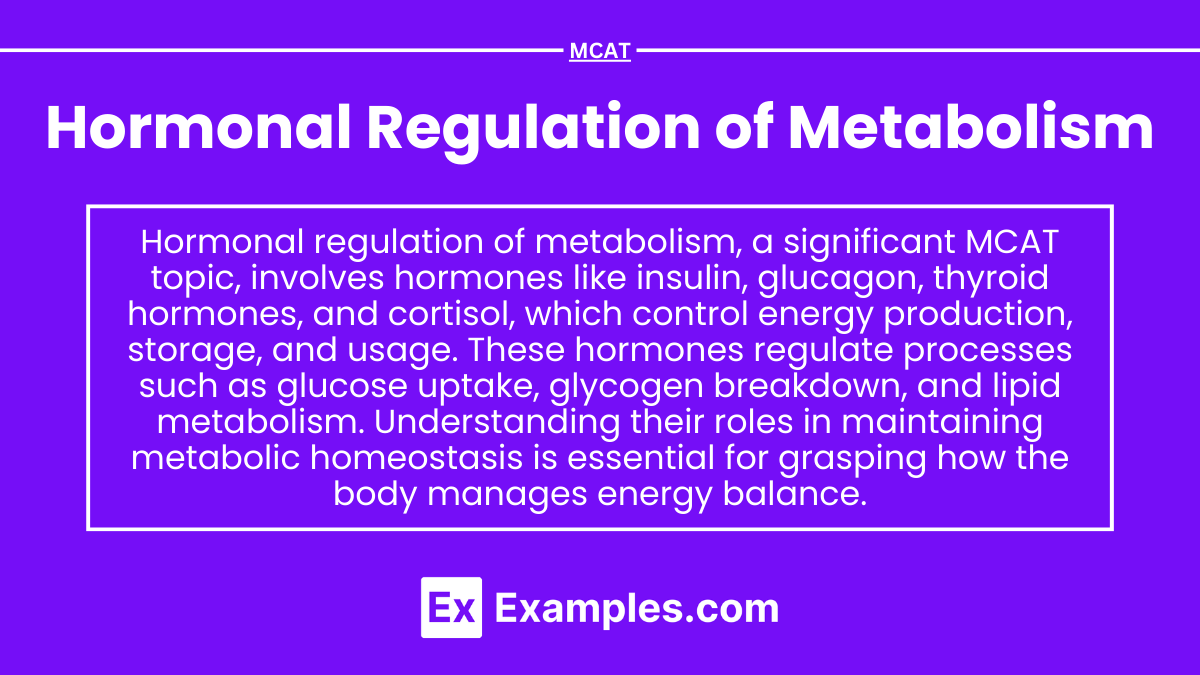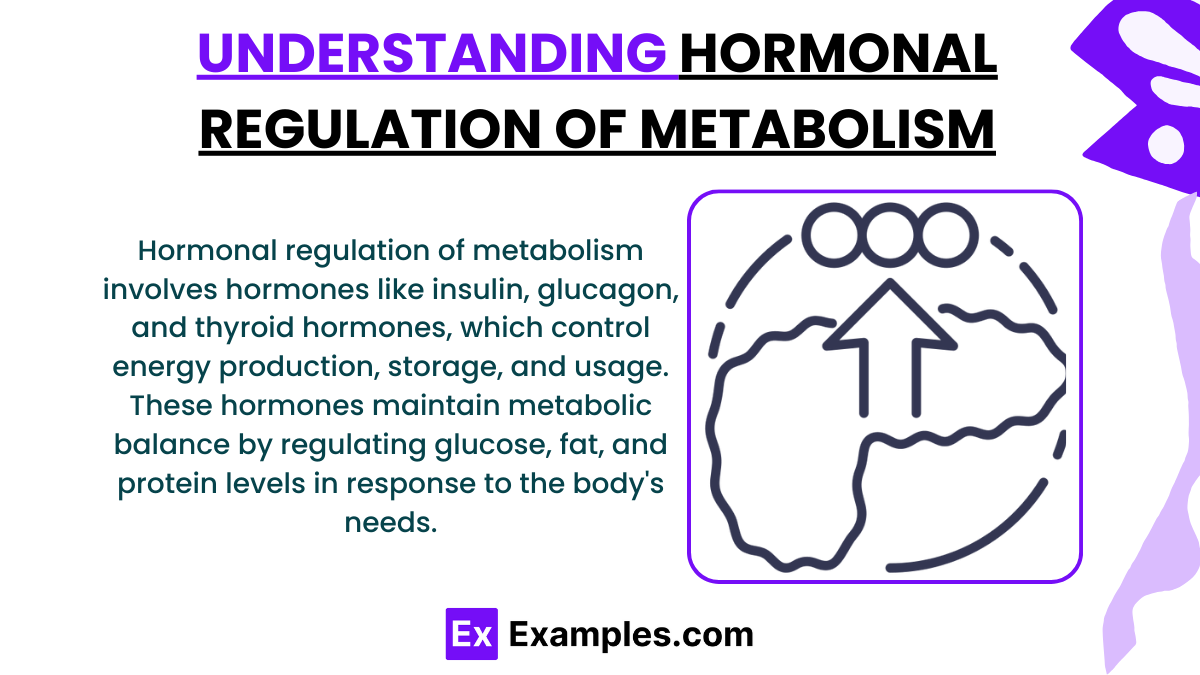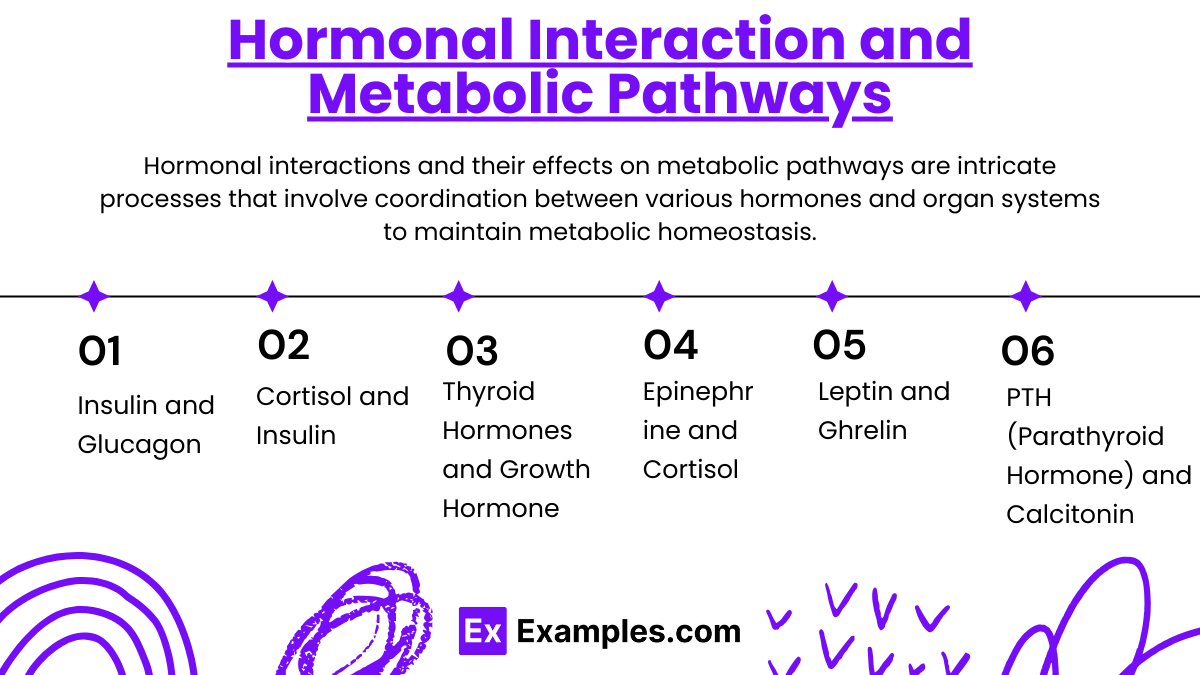Preparing for the MCAT requires a solid understanding of hormonal regulation of metabolism, a key component of the Organ Systems foundation. Mastery of how hormones like insulin, glucagon, and cortisol control metabolic pathways provides crucial insights into maintaining energy balance, critical for achieving a high MCAT score.
Learning Objective
In studying "Hormonal Regulation of Metabolism" for the MCAT, you should aim to understand how hormones influence metabolic processes within the body. Learn the roles and mechanisms of key hormones such as insulin, glucagon, thyroid hormones, and cortisol. Explore how these hormones interact to maintain energy homeostasis, influence nutrient storage, and regulate blood glucose levels. Evaluate the physiological impacts of hormonal imbalances and their link to metabolic disorders such as diabetes and thyroid dysfunction. Apply this knowledge to solve complex clinical scenarios and interpret experimental data in MCAT practice passages, focusing on how hormonal regulation integrates with overall organ system function.
Understanding Hormonal Regulation of Metabolism
Hormonal regulation of metabolism involves hormones like insulin, glucagon, and thyroid hormones, which control energy production, storage, and usage. These hormones maintain metabolic balance by regulating glucose, fat, and protein levels in response to the body's needs.The regulation of metabolism by hormones involves a complex interplay of various hormones that influence how the body processes and utilizes energy. Here’s a general overview of how hormones regulate metabolism:
Insulin and Glucagon (Pancreas):
Insulin is released by the pancreas in response to high blood glucose levels. It promotes the uptake of glucose by cells, its conversion into glycogen in the liver and muscles, and the synthesis of fats in adipose tissues.
Glucagon is released when blood glucose levels are low. It stimulates the breakdown of glycogen in the liver to release glucose into the bloodstream and promotes the breakdown of fats.
Cortisol (Adrenal Glands):
Cortisol is known as the "stress hormone" and is released from the adrenal cortex. It has a catabolic effect, meaning it promotes the breakdown of complex molecules. Cortisol increases blood glucose levels by stimulating gluconeogenesis (formation of glucose from non-carbohydrate sources) in the liver and inhibiting glucose uptake in the muscles and adipose tissue.
Thyroid Hormones (Thyroid Gland):
Thyroid hormones, including thyroxine (T4) and triiodothyronine (T3), play a crucial role in regulating metabolic rate. They increase the basal metabolic rate (BMR) by enhancing oxygen consumption and heat production in tissues.
Epinephrine (Adrenal Medulla):
Epinephrine, also known as adrenaline, is released from the adrenal medulla during stress. It stimulates glycogenolysis (breakdown of glycogen to glucose) in the liver and muscle and lipolysis (fat breakdown) in adipose tissue, increasing blood glucose levels and fatty acids.
Leptin and Ghrelin (Adipose Tissue and Stomach):
Leptin is secreted by adipose cells and helps regulate energy balance by inhibiting hunger, which in turn diminishes fat storage in adipocytes.
Ghrelin is known as the "hunger hormone" and is released primarily from the stomach. It stimulates appetite and increases food intake.
Growth Hormone (Pituitary Gland):
Growth hormone has both anabolic and catabolic effects. It promotes protein synthesis in muscle and bone and supports the mobilization of fats.
Hormonal Interaction and Metabolic Pathways
Hormonal interactions and their effects on metabolic pathways are intricate processes that involve coordination between various hormones and organ systems to maintain metabolic homeostasis. Here's a detailed look at some key hormonal interactions and the metabolic pathways they influence:
1. Insulin and Glucagon
Interaction: Antagonistic effects on blood glucose levels; insulin lowers and glucagon raises.
Key Pathways:
Insulin promotes glycogenesis (glucose to glycogen) in liver and muscles.
Glucagon stimulates glycogenolysis (glycogen to glucose) and gluconeogenesis (new glucose production).
2. Cortisol and Insulin
Interaction: Cortisol counteracts insulin, increasing blood glucose and reducing insulin sensitivity during stress.
Key Pathways:
Cortisol stimulates gluconeogenesis and lipolysis, freeing up glucose and fatty acids for energy.
3. Thyroid Hormones and Growth Hormone
Interaction: Synergistic effects on growth and metabolic rate; thyroid hormones enhance tissue responsiveness to growth hormone.
Key Pathways:
Both increase basal metabolic rate and protein synthesis in tissues.
4. Epinephrine and Cortisol
Interaction: Stress hormones that mobilize energy stores.
Key Pathways:
Epinephrine and cortisol promote glycogenolysis and lipolysis for rapid energy availability.
5. Leptin and Ghrelin
Interaction: Opposite effects on appetite; leptin decreases and ghrelin increases hunger.
Key Pathways:
Leptin regulates energy expenditure and appetite suppression, while ghrelin stimulates hunger and food intake.
6. PTH (Parathyroid Hormone) and Calcitonin
Interaction: Regulate calcium levels; PTH increases and calcitonin decreases blood calcium.
Key Pathways:
PTH stimulates bone resorption to increase calcium release, calcitonin promotes calcium deposition in bones.
Clinical Implications and Disorders
Understanding the clinical implications of hormonal dysregulation can help in diagnosing and managing various disorders. Here’s an overview of some common disorders related to the hormones discussed and their metabolic implications:
1. Insulin and Glucagon
Diabetes Mellitus:
Type 1 Diabetes: Autoimmune destruction of insulin-producing beta cells in the pancreas, leading to high blood glucose levels.
Type 2 Diabetes: Characterized by insulin resistance and eventually insufficient insulin production; high blood glucose levels result from poor glucose uptake by cells.
Hypoglycemia: Can result from excessive insulin or insufficient glucagon, leading to dangerously low blood glucose levels.
2. Cortisol
Cushing's Syndrome: Caused by high cortisol levels, either from excessive adrenal gland production or long-term use of corticosteroid drugs. Symptoms include weight gain, thinning skin, and high blood pressure.
Addison’s Disease: Adrenal insufficiency leading to low cortisol levels, characterized by weight loss, muscle weakness, and low blood pressure.
3. Thyroid Hormones
Hyperthyroidism: Excessive thyroid hormone production, leading to weight loss, increased heart rate, and nervousness.
Hypothyroidism: Insufficient thyroid hormone production, resulting in fatigue, weight gain, and cold intolerance.
4. Epinephrine
Pheochromocytoma: A rare tumor of adrenal gland tissue that causes excessive production of epinephrine, leading to high blood pressure, palpitations, and anxiety.
5. Leptin and Ghrelin
Obesity: Leptin resistance is often seen in obesity, where high levels of leptin do not lead to appetite suppression.
Eating Disorders: Altered ghrelin levels can contribute to conditions like anorexia nervosa and bulimia.
6. PTH and Calcitonin
Hyperparathyroidism: Excessive PTH production leading to high calcium levels, bone weakness, and kidney stones.
Hypoparathyroidism: Low PTH levels leading to low calcium levels, muscle cramps, and tetany.
Examples
Example 1:Insulin and Blood Glucose Regulation
Postprandial (after eating) glucose regulation.
After a carbohydrate-rich meal, blood glucose levels rise, prompting the pancreas to release insulin. Insulin facilitates glucose uptake into cells, especially muscle and fat cells, and promotes glycogen synthesis in the liver, thereby lowering blood glucose levels to a normal range.
Example 2:Stress Response and Cortisol Release
Acute stress response.
In response to stress, the adrenal glands release cortisol, which enhances gluconeogenesis in the liver, increases fatty acid mobilization, and reduces glucose uptake in non-essential tissues. This ensures ample glucose availability for the brain and essential functions during stressful events.
Example 3:Glucagon's Role During Fasting
Response to fasting between meals.
As glucose levels drop several hours after eating, glucagon is secreted by the pancreas. Glucagon stimulates glycogen breakdown (glycogenolysis) and gluconeogenesis in the liver, increasing blood glucose levels to maintain energy supply until the next meal.
Example 4:Metabolic Effects of Thyroid Hormones
Regulation of basal metabolic rate.
Thyroid hormones (T3 and T4) are critical regulators of basal metabolic rate. They stimulate diverse metabolic activities across tissues, increasing oxygen consumption and heat production. An excess or deficiency of thyroid hormones can lead to hyperthyroidism or hypothyroidism, respectively, each with distinct metabolic symptoms.
Example 5:Insulin Sensitivity in Type 2 Diabetes
Insulin resistance development.
In type 2 diabetes, prolonged high glucose and insulin levels lead to decreased sensitivity of cells to insulin. As a result, the pancreas compensates by producing more insulin, but over time, this can lead to pancreatic beta-cell fatigue and further worsen blood glucose control.
Practice Questions
Question 1:
Which of the following is a primary action of insulin in metabolism?
A) Promotes gluconeogenesis in the liver
B) Enhances lipolysis in adipose tissue
C) Increases glucose uptake in muscle and adipose tissue
D) Stimulates protein catabolism
Answer: C) Increases glucose uptake in muscle and adipose tissue
Explanation:
Insulin primarily facilitates the uptake of glucose by muscle and fat cells and enhances glycogen synthesis in the liver and muscle. This action lowers blood glucose levels and promotes energy storage. Unlike options A and B, insulin actually inhibits gluconeogenesis and lipolysis. Option D is incorrect as insulin promotes protein synthesis, not catabolism.
Question 2:
What is the role of cortisol in the body's response to fasting?
A) Decreases blood glucose levels to conserve energy
B) Increases protein synthesis in muscles
C) Promotes gluconeogenesis and lipolysis
D) Inhibits amino acid absorption from the gut
Answer: C) Promotes gluconeogenesis and lipolysis
Explanation:
Cortisol helps maintain glucose availability by promoting gluconeogenesis (production of glucose from non-carbohydrate sources) in the liver and lipolysis (breakdown of fats into fatty acids) in adipose tissue. This is crucial during fasting when dietary glucose is not available. Cortisol ensures that the brain and other vital organs receive sufficient energy.
Question 3:
Which of the following best describes the action of thyroid hormones on basal metabolic rate (BMR)?
A) Thyroid hormones decrease oxygen consumption and heat production
B) Thyroid hormones increase oxygen consumption and heat production
C) Thyroid hormones have no effect on metabolic processes
D) Thyroid hormones decrease glucose and fatty acid metabolism
Answer: B) Thyroid hormones increase oxygen consumption and heat production
Explanation:
Thyroid hormones, including thyroxine (T4) and triiodothyronine (T3), are known to increase basal metabolic rate by enhancing oxygen consumption and heat production in tissues. This effect accelerates various metabolic processes throughout the body, contributing to increased energy expenditure and temperature regulation.





